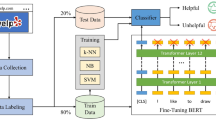Abstract
Number of users of social media is increasing exponentially. People are getting addicted to social media, and because of such addiction, it sometimes causes psychological and mental effects on the users. Understanding user interaction with social media is essential to study personality traits of the users. This paper focuses on classification of personality traits called Big Five factors, namely (i) agreeableness, (ii) conscientiousness, (iii) neuroticism, (iv) extraversion and (v) openness by combining image and textual features through ontology and fully connected neural network (FCNN). The intuition to classify the images of the five classes is that there is a strong correlation between images, profile picture, images of status, text in the images, description of the images uploaded on social media and the person’s mind. To extract such observation, we explore an ontology-based approach, which constructs a weighted undirected graph (WUG) based on labels of the images, profile picture, banner image, text in the images and description of the images in a novel way for feature extraction. The proposed approach uses mini-batch gradient descent to convert WUG to feature vector form for each word. Furthermore, the feature vectors are fed to the FCNN for classification of personality traits-oriented images. The proposed classification method is evaluated by testing on our dataset of five classes containing 5000 images and two benchmark datasets, namely 5-class dataset which provides 33,556 images, and 10-class dataset which provides 2000 images. The results on different datasets show that the proposed approach is superior to the existing methods in terms of average classification rate.






Similar content being viewed by others
References
Zhu, H., Li, L., Zhao, S., Jiang, H.: Evaluating attributed personality traits from scene perception probability. Pattern Recognit. Lett. 116, 121–126 (2018)
Raj, C., Meel, P.: ConvNet frameworks for multi-modal fake news detection. Appl. Intell. 51, 8132–8148 (2021)
Chaudhari, K., Thakkar, A.: Survey on handwriting-based personality trait identification. Expert Syst. Appl. 124, 282–308 (2019)
Antonakaki, D., Fragopoulou, P., Ioannidis, S.: A survey of Twitter research: data model, graph structure, sentiment analysis and attacks. Expert Syst. Appl. 164, 114006 (2021)
Rahman, M.A., Al Faisal, A., Khanam, T., Amjad, M., Siddik, M.S.: Personality detection from text using convolutional neural network. In: Proceedings of the ICASERT (2019)
Liu, L., Preoţiuc-Pietro, D., Samani, Z.R., Moghaddam, M.E., Ungar, L.: Analyzing personality through social media profile picture choice. In: Proceedings of the AAAI (2016)
Sharma, M., Jalal, A.S., Khan, A.: Emotion recognition using facial expression by fusing key points descriptor and texture features. Multimed. Tools Appl. 78, 16195–16219 (2019)
Ma, H., Celik, T., Li, H.C.: Lightweight attention convolutional neural network through network slimming for robust faical expression recongitoin. Signal Image Video Process. 15, 1507–1515 (2021)
Garaawi, N.A., Wu, O., Morris, T.: BRIEF-based face descriptor: an application to automatic faical expression recongition (AEER). Signal, Video Image Process. 15, 371–379 (2021)
Altuwairqi, K., Jarraya, S.K., Allinjawi, A., Hammami, M.: Student behavior analysis to measure engagement levels online learning environments. Signal Video Image Process. 15, 1387–1395 (2021)
Amraee, S., Vafei, A., Jamshidi, K., Adibi, P.: Abnormal event detection in crowded scenes using one-class SVM. Signal Video Image Process. 12, 115–1123 (2018)
Mabrouk, O., Hlaoua, L., Omri, M.N.: Exploiting ontology information in fuzzy SVM social media profile classification. Appl. Intell. 51, 3757–3774 (2021)
Patil, V., Mathur, H.: A survey: machine learning approach for personality analysis and writer identification through handwriting. In: Proceedings of the ICICT, pp. 1–5 (2020). https://doi.org/10.1109/ICICT48043.2020.9112449
Bargshady, G., Zhou, X., Deo, R.C., Soar, J., Whittaker, F., Wang, H.: Enhanced deep learning algorithm development to detect pain intensity from facial expression images. Expert Syst. Appl. 149, 113305 (2020)
Bozorgtabar, B., Mahapatra, D., Thiran, J.P.: ExprADA: adversarial domain adaptation for facial expression analysis. Pattern Recognit. 100, 107111 (2020)
Mungra, D., Agrawal, A., Sharma, P., Tanwar, S., Obaidat, M.S.: PRATIT: a CNN-based emotion recognition system using histogram equalization and data augmentation. Multimed. Tools Appl. 79, 2285–2307 (2020)
Palhano, D.B., Dos Machado, L.S., De Almeida, A.A.F.: Paki Mirabolandia: a serious game to identify player personality. In: Proceedings of the ICCTD (2020)
Lai, S., Sun, B., Wu, F., Xiao, R.: Automatic personality identification using students’ online learning behavior. IEEE Trans. Learn. Technol. 13, 26–37 (2020)
Krishnani, D., Shivakumara, P., Lu, T., Pal, U., Ramachandra, R.: Structure function based transform features for behavior-oriented social media image classification. In: Palaiahnakote, S., di Baja, G.S., Wang, L., Yan, W.Q. (eds.) Pattern Recognition, pp. 594–608. Springer, Cham (2020)
Xue, D., Wu, L., Hong, Z., Guo, S., Gao, L., Wu, Z., Zhong, X., Sun, J.: Deep learning-based personality recognition from text posts of online social network. Appl. Intell. 48, 4232–4246 (2018)
Xue, X., Feng, J., Sun, X.: Semantic-enhanced sequential modeling for personality trait recognition from texts. Appl. Intell. 51, 7705–7717 (2021)
Tian, C., Rong, W., Zhou, S., Zhang, J., Ouyang, Y., Xiong, Z.: Texts learning word representation by jointly using neighbor and syntactic contexts. Neurocomputing 456, 136–146 (2021)
Pennington, J., Socher, R., Manning, C.D.: GloVe: global vectors for word representation. In: Proceedings of the EMNLP (2014)
Guntuku, S.C., Lin, W., Carpenter, J., Ng, W.K., Ungar, L.H., Preotiuc-Pietro, D.: Studying personality through the content of posted and liked images on Twitter. In: Proceedings of the ACM on Web Science Conference, pp. 223–227 (2017). https://doi.org/10.1145/3091478.3091522
Acknowledgements
This work receives partial support from FRGS Grant (FP104-2020), Ministry of Higher Education, Malaysia.
Author information
Authors and Affiliations
Corresponding author
Additional information
Publisher's Note
Springer Nature remains neutral with regard to jurisdictional claims in published maps and institutional affiliations.
Rights and permissions
About this article
Cite this article
Biswas, K., Shivakumara, P., Pal, U. et al. A new ontology-based multimodal classification system for social media images of personality traits. SIViP 17, 543–551 (2023). https://doi.org/10.1007/s11760-022-02259-3
Received:
Revised:
Accepted:
Published:
Issue Date:
DOI: https://doi.org/10.1007/s11760-022-02259-3




